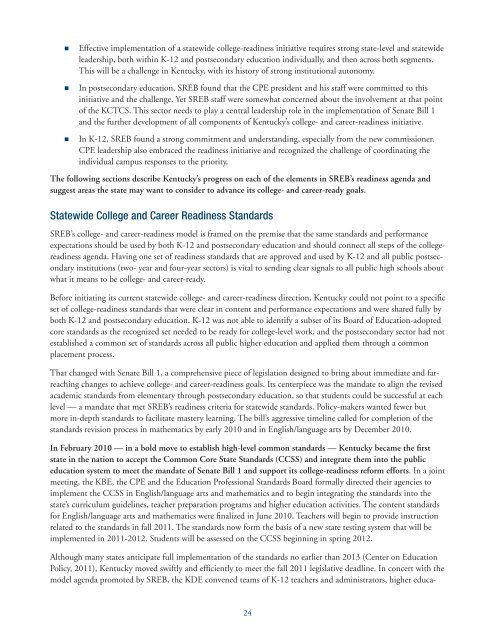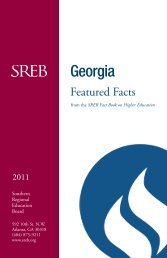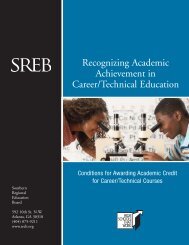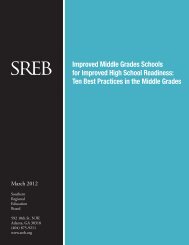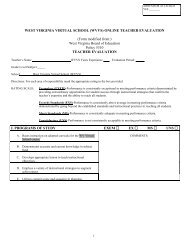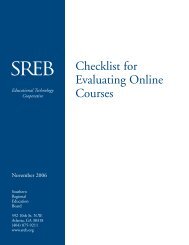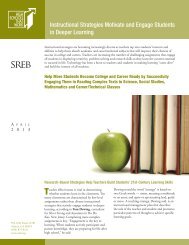Final Progress Reports - Southern Regional Education Board
Final Progress Reports - Southern Regional Education Board
Final Progress Reports - Southern Regional Education Board
You also want an ePaper? Increase the reach of your titles
YUMPU automatically turns print PDFs into web optimized ePapers that Google loves.
Effective implementation of a statewide college-readiness initiative requires strong state-level and statewide<br />
leadership, both within K-12 and postsecondary education individually, and then across both segments.<br />
This will be a challenge in Kentucky, with its history of strong institutional autonomy.<br />
In postsecondary education, SREB found that the CPE president and his staff were committed to this<br />
initiative and the challenge. Yet SREB staff were somewhat concerned about the involvement at that point<br />
of the KCTCS. This sector needs to play a central leadership role in the implementation of Senate Bill 1<br />
and the further development of all components of Kentucky’s college- and career-readiness initiative.<br />
In K-12, SREB found a strong commitment and understanding, especially from the new commissioner.<br />
CPE leadership also embraced the readiness initiative and recognized the challenge of coordinating the<br />
individual campus responses to the priority.<br />
The following sections describe Kentucky’s progress on each of the elements in SREB’s readiness agenda and<br />
suggest areas the state may want to consider to advance its college- and career-ready goals.<br />
Statewide College and Career Readiness Standards<br />
SREB’s college- and career-readiness model is framed on the premise that the same standards and performance<br />
expectations should be used by both K-12 and postsecondary education and should connect all steps of the collegereadiness<br />
agenda. Having one set of readiness standards that are approved and used by K-12 and all public postsecondary<br />
institutions (two- year and four-year sectors) is vital to sending clear signals to all public high schools about<br />
what it means to be college- and career-ready.<br />
Before initiating its current statewide college- and career-readiness direction, Kentucky could not point to a specific<br />
set of college-readiness standards that were clear in content and performance expectations and were shared fully by<br />
both K-12 and postsecondary education. K-12 was not able to identify a subset of its <strong>Board</strong> of <strong>Education</strong>-adopted<br />
core standards as the recognized set needed to be ready for college-level work, and the postsecondary sector had not<br />
established a common set of standards across all public higher education and applied them through a common<br />
placement process.<br />
That changed with Senate Bill 1, a comprehensive piece of legislation designed to bring about immediate and farreaching<br />
changes to achieve college- and career-readiness goals. Its centerpiece was the mandate to align the revised<br />
academic standards from elementary through postsecondary education, so that students could be successful at each<br />
level — a mandate that met SREB’s readiness criteria for statewide standards. Policy-makers wanted fewer but<br />
more in-depth standards to facilitate mastery learning. The bill’s aggressive timeline called for completion of the<br />
standards revision process in mathematics by early 2010 and in English/language arts by December 2010.<br />
In February 2010 — in a bold move to establish high-level common standards — Kentucky became the first<br />
state in the nation to accept the Common Core State Standards (CCSS) and integrate them into the public<br />
education system to meet the mandate of Senate Bill 1 and support its college-readiness reform efforts. In a joint<br />
meeting, the KBE, the CPE and the <strong>Education</strong> Professional Standards <strong>Board</strong> formally directed their agencies to<br />
implement the CCSS in English/language arts and mathematics and to begin integrating the standards into the<br />
state’s curriculum guidelines, teacher preparation programs and higher education activities. The content standards<br />
for English/language arts and mathematics were finalized in June 2010. Teachers will begin to provide instruction<br />
related to the standards in fall 2011. The standards now form the basis of a new state testing system that will be<br />
implemented in 2011-2012. Students will be assessed on the CCSS beginning in spring 2012.<br />
Although many states anticipate full implementation of the standards no earlier than 2013 (Center on <strong>Education</strong><br />
Policy, 2011), Kentucky moved swiftly and efficiently to meet the fall 2011 legislative deadline. In concert with the<br />
model agenda promoted by SREB, the KDE convened teams of K-12 teachers and administrators, higher educa-<br />
24


